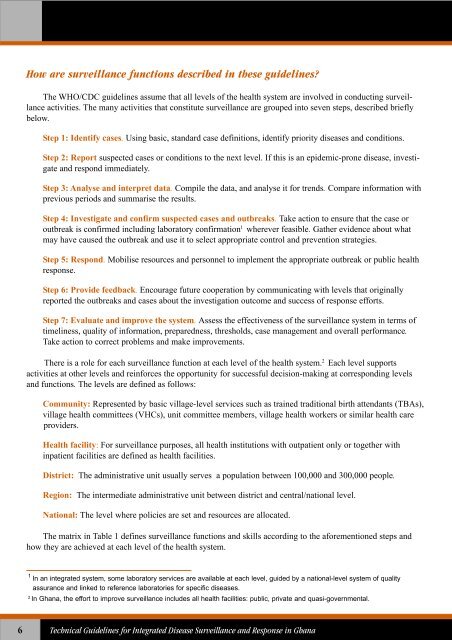Technical Guidelines for Integrated Disease Surveillance ... - PHRplus
Technical Guidelines for Integrated Disease Surveillance ... - PHRplus
Technical Guidelines for Integrated Disease Surveillance ... - PHRplus
You also want an ePaper? Increase the reach of your titles
YUMPU automatically turns print PDFs into web optimized ePapers that Google loves.
How are surveillance functions described in these guidelines?The WHO/CDC guidelines assume that all levels of the health system are involved in conducting surveillanceactivities. The many activities that constitute surveillance are grouped into seven steps, described brieflybelow.Step 1: Identify cases. Using basic, standard case definitions, identify priority diseases and conditions.Step 2: Report suspected cases or conditions to the next level. If this is an epidemic-prone disease, investigateand respond immediately.Step 3: Analyse and interpret data. Compile the data, and analyse it <strong>for</strong> trends. Compare in<strong>for</strong>mation withprevious periods and summarise the results.Step 4: Investigate and confirm suspected cases and outbreaks. Take action to ensure that the case oroutbreak is confirmed including laboratory confirmation 1 wherever feasible. Gather evidence about whatmay have caused the outbreak and use it to select appropriate control and prevention strategies.Step 5: Respond. Mobilise resources and personnel to implement the appropriate outbreak or public healthresponse.Step 6: Provide feedback. Encourage future cooperation by communicating with levels that originallyreported the outbreaks and cases about the investigation outcome and success of response ef<strong>for</strong>ts.Step 7: Evaluate and improve the system. Assess the effectiveness of the surveillance system in terms oftimeliness, quality of in<strong>for</strong>mation, preparedness, thresholds, case management and overall per<strong>for</strong>mance.Take action to correct problems and make improvements.There is a role <strong>for</strong> each surveillance function at each level of the health system. 2 Each level supportsactivities at other levels and rein<strong>for</strong>ces the opportunity <strong>for</strong> successful decision-making at corresponding levelsand functions. The levels are defined as follows:Community: Represented by basic village-level services such as trained traditional birth attendants (TBAs),village health committees (VHCs), unit committee members, village health workers or similar health careproviders.Health facility: For surveillance purposes, all health institutions with outpatient only or together withinpatient facilities are defined as health facilities.District: The administrative unit usually serves a population between 100,000 and 300,000 people.Region: The intermediate administrative unit between district and central/national level.National: The level where policies are set and resources are allocated.The matrix in Table 1 defines surveillance functions and skills according to the a<strong>for</strong>ementioned steps andhow they are achieved at each level of the health system.1 In an integrated system, some laboratory services are available at each level, guided by a national-level system of qualityassurance and linked to reference laboratories <strong>for</strong> specific diseases.2In Ghana, the ef<strong>for</strong>t to improve surveillance includes all health facilities: public, private and quasi-governmental.6<strong>Technical</strong> <strong>Guidelines</strong> <strong>for</strong> <strong>Integrated</strong> <strong>Disease</strong> <strong>Surveillance</strong> and Response in Ghana















